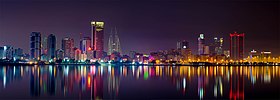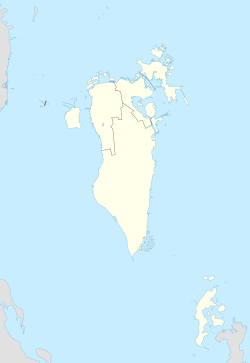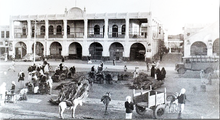Manama
Manama
الْمَنَامَة | |
|---|---|
Clockwise from top:Bahrain World Trade Center;skyline with roads, towers and harbour of Manama; night view of Manama City; and Manama City view | |
| Coordinates:26°13′30″N50°34′39″E/ 26.22500°N 50.57750°E | |
| Country | |
| Governorate | Capital |
| Government | |
| • Governor | Hamad bin Isa Al Khalifa |
| Area | |
| •Capital city | 30 km2(10 sq mi) |
| Population | |
| • Estimate (2020) | 200,000 |
| • Density | 5,200/km2(13,000/sq mi) |
| •Urban (2020)[1] | 635,000 |
| •Capital Governorate(2020) | 534,939 |
| Time zone | GMT+3 |
| Block number | 3XX–4XX |
| Website | capital |
Manama(Arabic:الْمَنَامَةel-Menâme,Bahranipronunciation:[elmɐˈnɑːmɐ]) is the capital andlargest cityofBahrain,with an approximate population of 200,000 as of 2020. Long an important trading center in thePersian Gulf,Manama is home to a very diverse population. After periods ofPortugueseandPersiancontrol and a short invasion from the ruling dynasty ofSaudi Arabia,followed by a longer invasion byOman,Bahrain established itself as anindependent nationin 1971 following a period of British hegemony.
Although the current twin cities of Manama andMuharraqappear to have been founded simultaneously in the 1800s,[2]Muharraq took prominence due to its defensive location and was thus the capital of Bahrain until 1923. Manama became the mercantile capital and was the gateway to the mainBahrain Island.[3]In the 20th century, Bahrain's oil wealth helped spur fast growth and in the 1990s a concerteddiversificationeffort led to expansion in other industries and helped transform Manama into an important financial hub in theMiddle East.Manama was designated as the 2012capital of Arab cultureby theArab League,and abeta global cityby theGlobalization and World Cities Research Networkin 2018.[4][5]
Etymology
[edit]The name is derived from theArabicword الْمَنَامَة (el-Menâme) meaning "the place of rest" or "the place of dreams".[6]
History
[edit]Pre-modern history
[edit]There is evidence of human settlement on the northern coastline of Bahrain dating back to theBronze Age.TheDilmuncivilisation inhabited the area in 3000 BC, serving as a key regional trading hub betweenMesopotamia,Maganand theIndus Valley civilisation.[7][8]Approximately 100,000Dilmun burial moundswere found across the north and central regions of the country, some originating 5,000 years ago. Despite the discovery of the mounds, there is no significant evidence to suggest heavy urbanisation took place during theDilmunera.[9]It is believed that the majority of the population lived in rural areas, numbering several thousand. Evidence of an ancient large rural population was confirmed by one ofAlexander the Great's ship captains, during voyages in thePersian Gulf.A vast system ofaqueductsin northern Bahrain helped facilitate ancient horticulture and agriculture.[10]
"The capital ofAwal... is a town well populated whose environs are fertile and produce corn and dates in abundance. "

The commercial network of Dilmun lasted for almost 2,000 years, after which theAssyrianstook control of the island in 700 BC for more than a century. This was followed byBabylonianandAchaemenidrule, which later gave way to Greek influence during the time ofAlexander the Great's conquests.[11]In the first century AD, the Roman writerPliny the Elderwrote ofTylos,the Hellenic name of Bahrain in theclassical era,and itspearlsand cotton fields.[8]The island came under the control of theParthianandSassanidempires respectively, by which timeNestorian Christianitystarted to spread in Bahrain. By 410–420 AD, a Nestorianbishopricandmonasterywas established inAl Dair,on the neighbouring island ofMuharraq.[8][12]Following the conversion of Bahrain toIslamin 628 AD, work on one of the earliest mosques in the region, theKhamis Mosque,began as early as the seventh century AD. During this time, Bahrain was engaged in long distance marine trading, evident from the discovery ofChinese coinsdating between 600 and 1200 AD, in Manama.[8]
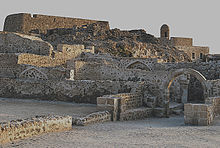
In 1330, under theJarwanid dynasty,the island became a tributary of theKingdom of Hormuz.The town of Manama was mentioned by name for the first time in a manuscript dating to 1345 AD.[8]Bahrain, particularly Manama and the nearby settlement ofBilad Al Qadeem,became a centre ofShiascholarship and training for theulema,it would remain so for centuries. The ulema would help fundpearlingexpeditions and finance grain production in the rural areas surrounding the city. In 1521, Bahrain fell to the expandingPortuguese Empirein the Persian Gulf, having already defeated Hormuz.[13]The Portuguese consolidated their hold on the island by constructing theBahrain Fort,on the outskirts of Manama.[14]After numerous revolts and an expandingSafavid empirein Persia, the Portuguese were expelled from Bahrain and the Safavids took control in 1602.[14]
Early modern history
[edit]The Safavids, sidelining Manama, designated the nearby town ofBilad Al Qadeemas the provincial capital.[15]The town was also the seat of the Persian governor and theShaikh al-Islamof the islands. The position of Shaikh al-Islam lay under the jurisdiction of the central Safavid government and as such, candidates were carefully vetted by theIsfahancourts. During the Safavid era, the islands continued to be a centre forTwelver Shi'ismscholarship, producing clerics for use in mainland Persia.[15]Additionally, the rich agricultural northern region of Bahrain continued to flourish due to an abundance ofdate palmfarms and orchards. The Portuguese travelerPedro Teixeiracommented on the extensive cultivation of crops likebarleyand wheat. The opening of Persian markets to Bahraini exports, especiallypearls,boosted the islands' export economy. The yearly income of exported Bahraini pearls was 600,000ducats,collected by around 2,000 pearlingdhows.[13]Another factor that contributed to Bahrain's agricultural wealth was the migration ofShiacultivators fromOttoman-occupiedQatifandal-Hasa,fearing religious persecution, in 1537.[15]Sometime after 1736,Nader Shahconstructed a fort on the southern outskirts of Manama (likely the Diwan Fort).[16]
Persian control over the Persian Gulf waned during the later half of the 18th century. At this time, Bahrain archipelago was a dependency of the emirate ofBushehr,itself a part ofPersia.In 1783, theBani Utbahtribal confederationinvadedBahrain and expelled the resident governorNasr Al-Madhkur.As a result, theAl Khalifafamily became the rulers of the country, and all political relations withBushehrandPersia/Iranwere terminated.Ahmed ibn Muhammad ibn Khalifa(later called Ahmed al-Fateh, lit. "Ahmed the conqueror" ) become the dynasty's firstHakim of Bahrain.Political instability in the 19th century had disastrous effects on Manama's economy; Invasions by the Omanis in 1800 and by theWahhabisin 1810–11, in addition to a civil war in 1842 between Bahrain's co-rulers saw the town being a major battleground. The instability paralysed commercial trade in Manama; the town's port was closed, most merchants fled abroad toKuwaitand the Persian coast until hostilities ceased.[17]The English scholarWilliam Gifford Palgrave,on a visit to Manama in 1862, described the town as having a few ruined stone buildings, with a landscape dominated with the huts of poor fishermen and pearl-divers.[18][17]

ThePax Britannicaof the 19th century resulted in British consolidation of trade routes, particularly those close to theBritish Raj.In response to piracy in the Persian Gulf region, the British deployed warships and forced much of the Persian Gulf States at the time (including Bahrain) to sign theGeneral Maritime Treaty of 1820,which prohibited piracy and slavery.[13]In 1861, thePerpetual Truce of Peace and Friendshipwas signed between Britain and Bahrain, which placed the British in charge of defending Bahrain in exchange for British control over Bahraini foreign affairs. With the ascension ofIsa ibn Ali Al Khalifaas the Hakim of Bahrain in 1869, Manama became the centre of British activity in the Persian Gulf, though its interests were initially strictly commercial.[19]Trading recovered fully by 1873 and the country's earnings from pearl exports increased by sevenfold between 1873 and 1900.[20]Representing the British were native agents, usually from minorities such asPersiansorHuwalawho regularly reported back to British India and theBritish political residencyinBushehr.[21]The position of native agent was later replaced by a British political agent, following the construction of the British political residency (locally referred to inArabic:بيت الدولة) in 1900, which further solidified Britain's position in Manama.[21]
Modern history
[edit]
Following the outbreak ofWorld War Iin 1914, theBritish Rajused Manama as a military base of operations during theMesopotamian campaign.[22]Prompted by the presence of oil in the region, the British political agency inBushireconcluded an oil agreement with the Hakim to prohibit the exploration and exploitation of oil for a five-year period. In 1919, Bahrain was officially integrated into theBritish empireas an overseas imperial territory following the Bahrainorder-in-councildecree, issued in 1913.[22]The decree gave the resident political agent greater powers and placed Bahrain under theresidency of Bushireand therefore under the governance of the British Raj. The British pressured a series ofadministrative reforms in Bahrain during the 1920s(a move met with opposition from tribal leaders), during which the aging HakimIsa ibn Ali Al Khalifawas forced to abdicate in favour of his reform-minded sonHamad ibn Isa Al Khalifa.A municipal government was established in Manama in 1919, the Customs office was reorganised in 1923 and placed under the supervision of an English businessman, the pearling industry was later reformed in 1924. Earnings from the customs office would be kept in the newly createdstate treasury.Civil courtswere established for the first time in 1923, followed by the establishment of the Department of Land Registration in 1924.[23]Charles Belgrave,from theColonial office,was appointed in 1926 by the British to carry on further reforms and manage administration as a financial advisor to the King. He later organised the State Police and was in charge of the Finance and Land departments of the government.[24]
In 1927, the country's pearling economy collapsed due to the introduction of Japanese cultured pearls in the world market. It is estimated that between 1929 and 1931, pearling entrepreneurs lost more than two-thirds of their income. Further aggravated by theGreat Depression,many leading Bahraini businessmen, shopkeepers, and pearl-divers fell into debt.[25]With thediscovery of oilin 1932 and the subsequent production of oil exports in 1934, the country gained a greater significance in geopolitics. The security of oil supplies in the Middle East was a priority of the British, especially in the run-up to the Second World War.[26]The discovery of oil led to gradual employment of bankrupt divers from the pearling industry in the 1930s, eventually causing the pearling industry to disappear.[27]During the war, the country served as a strategic airbase between Britain and India as well as hostingRAF Muharraqand anaval baseinJuffair.[28]Bahrain wasbombedby theItalian Air Forcein 1940. In 1947, following the end of the war and subsequent Indian independence, the British residency of the Persian Gulf moved to Manama fromBushire.[26]

Following the rise ofArab nationalismacross the Middle East and sparked by theSuez Crisisin 1956, anti-British unrest broke out in Manama, organised by theNational Union Committee.Though the NUC advocated peaceful demonstrations, buildings and enterprises belonging to Europeans (the British in particular) as well as the mainCatholicchurch in the city and petrol stations, were targeted and set ablaze.[29]Demonstrations held in front of the British political residency called for the dismissal of Charles Belgrave, who was later dismissed by the direct intervention of theForeign Officethe following year.[30]A subsequent crackdown on the NUC led to the dissolution of the body. Anotheranti-British uprisingerupted in March 1965, though predominately led by students aspiring for independence rather than by Arab nationalists.[a]In 1968, the British announced their withdrawal from Bahrain by 1971.[32]The newly independentState of Bahraindesignated Manama as the capital city.[31]


Post-independence Manama was characterised by the rapid urbanisation of the city and the swallowing-up of neighboring villages and hamlets into a single urbanised area, incorporating new neighbourhoods such asAdliyaandSalmaniya.The construction boom attracted large numbers of foreigners from theIndian subcontinentand by 1981, foreigners outnumbered Bahrainis two-to-one.[33]The construction of theDiplomatic Areadistrict in the city's northeast helped facilitate diversification of the country's economy from oil by exploiting the lucrative financial industry. Financial institutions in the district numbered 187 by 1986. The scarcity of land suitable for construction led toland reclamation.[34]Religious activism migrated from Manama to the suburban districts ofBani Jamra,DirazandBilad Al Qadeem,hotspots of unrest in the1990s uprisingthat called for the reinstatement of an elected parliament.[35]In 2001, theNational Action Charter,presented by KingHamad bin Isa al-Khalifawas approved by Bahrainis. The charter led to the firstparliamentaryand municipal elections in decades.[35]Further elections in 2006 and 2010 led to the election of Islamist parties,Al Wefaq,Al Menbar,andAl Asalah,as well as independent candidates.[35]In 2011, amonth-long uprisingled to the intervention ofGCC forcesand the proclamation of a three-monthstate of emergency.TheBahrain Independent Commission of Inquirypublished a 500-page report on the events of 2011.[36]
Government
[edit]
Historically, Manama has been restricted to what is now known as theManama Souqand the Manama Fort (now the Ministry of Interior) to its south. However the city has now grown to include a number of newer suburban developments as well as older neighboring villages that have been engulfed by the growth of the city. The districts that make up Manama today include:
Manama is part of theCapital Governorate,one of fiveGovernorates of Bahrain.Until 2002 it was part of the municipality of Al-Manamah. Councils exist within the governorates; eight constituencies are voted upon within Capital Governorate in 2006.[37]
Economy
[edit]
Manama is the focal point of the Bahraini economy. While petroleum has decreased in importance in recent years due to depleting reserves and growth in other industries, it is still the mainstay of the economy.Heavy industry(e.g. aluminiumsmelting,ship repair), banking and finance, and tourism are among the industries which have experienced recent growth. Several multinationals have facilities and offices in and around Manama.[38]The primary industry in Manama itself is financial services, with over two hundred financial institutions and banks based in theCBDand theDiplomatic Area.Manama is a financial hub for the Persian Gulf region and a center ofIslamic banking.There is also a large retail sector in the shopping malls aroundSeef,while the center of Manama is dominated by small workshops and traders.
Manama's economy in the early 20th century relied heavily onpearling;in 1907, the pearling industry was estimated to include 917 boats providing employment for up to 18,000 people.Shipbuildingalso employed several hundred in both Manama andMuharraq.The estimated income earned from pearling in 1926 and subsequent years prior to theGreat Depressionwas £1.5 million annually.Custom dutiesandtariffsserved as the prime source of revenue for the government. With the onset of the Great Depression, the collapse of the pearling industry and thediscovery of oilin 1932, the country's economy began to shift towards oil.[39]
Historically, the ports at Manama were of poor reputation. The British described the ports importing systems as being "very bad – goods were exposed to the weather and there were long delays in delivery", in 1911. Indians began maintaining the ports and new resources were built on site, improving the situation. As of 1920, Manama was one of the main exporters ofBahrain pearls,attractingsteamshipsfrom India. During this time, they also imported goods from India and from other regional countries. They imported rice, textiles,ghee,coffee, dates, tea, tobacco, fuel, and livestock. They exported less of a variety, with a focus on pearls,oysters,andsailcloth.For the year of 1911–12, Manama was visited by 52 steamships, the majority being British and the rest Turkish-Arabian.[40]
Demographics
[edit]| Year | Pop. | ±% |
|---|---|---|
| 1860s | 8,000 | — |
| 1904 | 25,000 | +212.5% |
| 1941 | 27,835 | +11.3% |
| 1950 | 39,648 | +42.4% |
| 1959 | 61,726 | +55.7% |
| 1965 | 79,098 | +28.1% |
| 1971 | 88,785 | +12.2% |
| 1981 | 121,986 | +37.4% |
| 2010 | 329,510 | +170.1% |
| Source:[41]Bahrain Census 2010 | ||
The role of Manama as a regional port city in the Persian Gulf made it a hub for migrant workers in search of a better living. As a result, Manama has often been described, both in the pre-oil and post-oil era, as acosmopolitancity.[42]In 1904, it was estimated that Manama's population numbered 25,000, out of which half were believed to have been foreigners fromBasra,Najd,al-HasaandIran,as well as from India and Europe.[20]
Religion
[edit]The two main branches ofIslam,Shia IslamandSunni Islam,coexisted in Manama for centuries and are represented by distinct ethnic groups. The Shia community is represented by the native ArabBaharna,theHasawisandQatifisof mainland Arabia and the PersianAjam.[42]The Sunni community is represented by ArabBedouintribes who migrated in the eighteenth century along with theBani Utbahand theHuwala.
Transport
[edit]Road network
[edit]


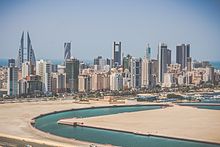
Manama is the main hub of the country's road network. At the moment the city's road network is undergoing substantial development to ameliorate the situation of traffic in the city. Due to the fact that it is the capital and the main city in the country, where most of the government and the commercial offices and facilities are established, along with the entertainment centers, and the country's fast growth, vehicle population is increasing rapidly.
The widening of roads in the old districts of Manama and the development of a national network linking the capital to other settlements commenced as early as the arrival of the first car in 1914.[43]The continuous increase in the number of cars from 395 in 1944,[43]to 3,379 in 1954 and to 18,372 cars in 1970[43]causedurban developmentto primarily focus on expanding the road network, wideningcarriagewaysand the establishment of more parking spaces.[43]Many tracks previously laid in the pre-oil era (prior to the 1930s) were resurfaced and widened, turning them into 'road arteries'. Initial widening of the roads started in theManama Souqdistrict, widening its main roads by demolishing encroaching houses.[43]
A series ofring roadswere constructed (Isa al Kabeer avenue in the 1930s, Exhibition avenue in the 1960s and Al Fateh highway in the 1980s[43]), to push back thecoastlineand extend the city area in belt-like forms.[43]To the north, the foreshore used to be aroundGovernment Avenuein the 1920s but it shifted to a new road,King Faisal Road,in the early 1930s which became the coastal road.[43]To the east, a bridge connected Manama to Muharraq since 1929, a new causeway was built in 1941 which replaced the old wooden bridge.[43]Transits between the two islands peaked after the construction of theBahrain International Airportin 1932.[43]
To the south of Manama, roads connected groves, lagoons and marshes ofHoora,Adliya,GudaibiyaandJuffair.[43]Villages such asMahooz,Ghuraifa,Seqayaserved as the end of these roads. To the west, a major highway was built that linked Manama to the isolated village port ofBudaiya,[43]this highway crossed through the 'green belt' villages ofSanabis,JidhafsandDuraz.[43]To the south, a road was built that connected Manama toRiffa.The discovery of oil accelerated the growth of the city's road network.[43]

The four main islands and all the towns and villages are linked by well-constructed roads. There were 3,164 km (1,966 mi) of roadways in 2002, of which 2,433 km (1,512 mi) were paved. Acausewaystretching over 2.8 km (2 mi), connect Manama withMuharraq Island,and another bridge joinsSitrato the main island. A four-lane highway atop a 24 km (15 mi)causeway,linkingBahrainwith theSaudi Arabianmainland via the island ofUmm an-Nasanwas completed in December 1986, and financed bySaudi Arabia.In 2000, there were 172,684 passenger vehicles and 41,820 commercial vehicles.
Bahrain's port ofMina Salmancan accommodate 16 oceangoing vessels drawing up to 11 m (36 ft). In 2001, Bahrain had a merchant fleet of eight ships of 1,000GTor over, totaling 270,784 GT. Private vehicles and taxis are the primary means of transportation in the city.
Buses
[edit]
Manama has a bus service that launched on 1 April 2015, with a fleet of 141MAN buses.[44]Regulated by theMinistry of Transportation,bus routes extend across Bahrain and around Manama with fares of a minimum 200Fils(BD0.200) (around $0.50(USD); £0.30).[45]
Air transport
[edit]Bahrain International Airportis located on the nearbyMuharraq Island,approximately 7 km (4 mi) from theCBD.It is a premier hub airport in the Middle East. Strategically located in the NorthernPersian Gulfbetween the major markets ofSaudi ArabiaandIran,the airport has one of the widest range and highest frequency of regional services with connections to major international destinations in Europe, Asia, Africa, and North America. Bahrain also has a military airbase, theIsa Air Base,located in the south atSakhir.This is the base of the Bahrain Defence Force, or BDF.
Education
[edit]Quranic schools were the only source of education in Bahrain prior to the 20th century; such schools were primarily dedicated to the study of theQur'an.[46]The first modern school to open in the country was amissionaryelementary school set up in 1892 (according to one account) in Manama by theReformed Church in America,with the school's syllabus comprising English, Mathematics and the study of Christianity. Leading merchants in the country sent their children to the school until it was closed down in 1933 due to financial difficulties.[47]The school reopened some years later under the name ofAl Raja Schoolwhere it operates till the present day. In addition to the American Mission School, another foreign private school was opened in 1910; Al-Ittihad school, funded by thePersian community of Bahrain.[48]
Following the end of theFirst World War,Western ideasbecame more widespread in the country, culminating in the opening of the firstpublic schoolof Bahrain, Al-Hidaya Al-Khalifia Boys school, in the island ofMuharraqin 1919.[46]The school was founded by prominent citizens of Muharraq and was endorsed by theBahraini royal family.The country's first Education Committee was established by several leading Bahraini merchants, headed by Shaikh Abdulla bin Isa Al-Khalifa, the son of the then-ruler of BahrainIsa ibn Ali Al Khalifa,who acted as the de factoMinister of Education.The Education Committee was also responsible for managing the Al-Hidaya Boys school.[46]The school was, in fact, the brainchild of Shaikh Abdulla, who suggested the idea after returning from post-World War I celebrations in England.[49]
In 1926, a second public school for boys opened up in Manama called the Jafaria School. Two years later, in 1928, the first public school for girls was established. Due to financial constraints suffered by the Education Committee, the Bahraini government took control of the schools in 1930.[46]
Presently, Manama has a wide range of private and public universities and colleges such asAhlia University,Applied Science University,Arab Open University,Arabian Gulf University,Bahrain Institute of Banking and Finance,and theCollege of Health and Sport Sciences.Other notable primary and secondary schools situated in the city include theBahrain School,theIndian School,Al Raja Schoolamongst others.
Geography
[edit]The city is located in the north-eastern corner ofBahrainon a small peninsula. As in the rest of Bahrain, the land is generally flat (or gently rolling) andarid.
Climate
[edit]Manama has anarid climate.In common with the rest ofBahrain,Manama experiences extreme climatic conditions, with summer temperatures up to 45 °C (113 °F), and winter as low as 7 °C (45 °F) with evenhailon rare occasions. Average temperatures of the summer and winter seasons are generally from about 17 °C (63 °F) to about 34 °C (93 °F). The most pleasant time in Bahrain is spring when sunshine is comparatively low, coupled with mild temperatures moderated by soft breezes.
| Climate data for Manama (Bahrain International Airport) 1991–2020 normals, extremes 1902–present | |||||||||||||
|---|---|---|---|---|---|---|---|---|---|---|---|---|---|
| Month | Jan | Feb | Mar | Apr | May | Jun | Jul | Aug | Sep | Oct | Nov | Dec | Year |
| Record high °C (°F) | 29.7 (85.5) |
34.7 (94.5) |
38.1 (100.6) |
41.3 (106.3) |
46.7 (116.1) |
47.3 (117.1) |
47.5 (117.5) |
45.6 (114.1) |
45.5 (113.9) |
42.8 (109.0) |
37.2 (99.0) |
30.6 (87.1) |
47.5 (117.5) |
| Mean daily maximum °C (°F) | 20.7 (69.3) |
22.0 (71.6) |
25.5 (77.9) |
30.6 (87.1) |
36.1 (97.0) |
38.6 (101.5) |
39.7 (103.5) |
39.6 (103.3) |
37.7 (99.9) |
34.0 (93.2) |
28.0 (82.4) |
22.9 (73.2) |
31.3 (88.3) |
| Daily mean °C (°F) | 17.5 (63.5) |
18.4 (65.1) |
21.3 (70.3) |
26.0 (78.8) |
31.1 (88.0) |
34.0 (93.2) |
35.1 (95.2) |
35.1 (95.2) |
33.2 (91.8) |
29.9 (85.8) |
24.6 (76.3) |
19.7 (67.5) |
27.2 (80.9) |
| Mean daily minimum °C (°F) | 14.5 (58.1) |
15.4 (59.7) |
18.1 (64.6) |
22.4 (72.3) |
27.2 (81.0) |
30.0 (86.0) |
31.4 (88.5) |
31.5 (88.7) |
29.5 (85.1) |
26.4 (79.5) |
21.6 (70.9) |
16.8 (62.2) |
23.7 (74.7) |
| Record low °C (°F) | 2.7 (36.9) |
7.9 (46.2) |
10.9 (51.6) |
10.8 (51.4) |
18.7 (65.7) |
18.4 (65.1) |
25.3 (77.5) |
21.8 (71.2) |
18.9 (66.0) |
18.8 (65.8) |
11.7 (53.1) |
6.4 (43.5) |
2.7 (36.9) |
| Averageprecipitationmm (inches) | 18.1 (0.71) |
13.0 (0.51) |
14.7 (0.58) |
7.5 (0.30) |
8.0 (0.31) |
0.0 (0.0) |
0.0 (0.0) |
0.0 (0.0) |
0.0 (0.0) |
0.9 (0.04) |
16.8 (0.66) |
15.2 (0.60) |
94.2 (3.71) |
| Average precipitation days(≥ 1.0 mm) | 2.5 | 1.9 | 2.5 | 1.3 | 0.3 | 0.0 | 0.0 | 0.0 | 0.0 | 0.2 | 1.6 | 2.3 | 12.6 |
| Averagerelative humidity(%) | 69.1 | 67.2 | 61.5 | 54.4 | 47.6 | 46.2 | 50.7 | 58.0 | 59.2 | 62.3 | 63.6 | 68.7 | 59.0 |
| Averagedew point°C (°F) | 11.5 (52.7) |
11.8 (53.2) |
13.1 (55.6) |
15.4 (59.7) |
17.8 (64.0) |
19.9 (67.8) |
22.5 (72.5) |
25.0 (77.0) |
23.7 (74.7) |
21.5 (70.7) |
17.0 (62.6) |
13.7 (56.7) |
17.7 (63.9) |
| Mean monthlysunshine hours | 232 | 221 | 245 | 256 | 316 | 344 | 337 | 334 | 316 | 306 | 249 | 235 | 3,391 |
| Source: NOAA,[50]Meteo Climat (record highs and lows)[51] | |||||||||||||
Culture
[edit]
The country attracts a large number of foreigners and foreign influences, with just under one-third of the population hailing from abroad.[citation needed]Alcohol is legal in the country, with bars and nightclubs operating in the city. Bahrain gave women the right to vote in elections for the first time in 2002.Footballis the most popular sport in Manama (and the rest of the country), with three teams from Manama participating in theBahraini Premier League.
Notable cultural sites within Manama include theBab Al Bahrainand the adjacentsouqarea. In the 2010s, the historic core of Manama underwent revitalisation efforts alongside theManama souq,which were due to be completed in 2020.[52][53]Thecentral areasof Manama are also the main location forMuharram processions in the country,attracting hundreds of thousands of people annually from Bahrain and across the Gulf.
Notable people
[edit]- Hamad Al Fardan(born 1987), racing driver and musician
- Fahad Al Musalam(born 1974), racing driver
- Mohamed Ali Al-Shaaban(born 1986), television personality and surgeon
- Faisal Buressli(born 1961), former basketball player and current coach
- Hussain Karimi(born 1983), racing driver
Twin towns and sister cities
[edit]
|
See also
[edit]Notes
[edit]- ^These student protests were led by intellectuals and poets such asQassim Haddad.[31]
References
[edit]Citations
[edit]- ^Annual Population of Urban Agglomerations with 300,000 Inhabitants or More in 2014, by Country, 1950–2030 (thousands),World Urbanization Prospects, the 2014 revisionArchived18 February 2015 at theWayback Machine,Population Division of theUnited Nations Department of Economic and Social Affairs.Note: List based on estimates for 2015, from 2014. Retrieved 11 February 2017.
- ^Ben Hamouche 2008,p. 185.
- ^Ben Hamouche 2008,p. 186.
- ^Manama Capital of Arab Culture 2012
- ^"Ministry of Culture: Manama as the Bahraini Capital of Arab Culture".Archived fromthe originalon 11 September 2014.Retrieved9 October2014.
- ^Room 1997,p. 223.
- ^Al-Nabi 2012,p. 17.
- ^abcdeDumper & Stanley 2007,p. 243.
- ^Ben Hamouche 2008,p. 184.
- ^abAl-Nabi 2012,p. 19.
- ^Rice 2005,p. 128.
- ^Al A'ali, Mohammed (24 August 2013)."Protecting Bahrain's Christian heritage..."Gulf Daily News.Archived fromthe originalon 25 August 2013.Retrieved31 August2013.
- ^abcDumper & Stanley 2007,p. 244.
- ^abLarsen 1983,p. 68.
- ^abcFuccaro 2009,p. 18.
- ^Fuccaro 2005,p. 42.
- ^abFuccaro 2005,p. 43.
- ^Palgrave 1866.
- ^Ben Hamouche 2008,p. 192.
- ^abFuccaro 2005,p. 44.
- ^abFuccaro 2009,p. 64.
- ^abFuccaro 2009,p. 113.
- ^Fuccaro 2009,p. 114.
- ^Fuccaro 2009,p. 115.
- ^Fuccaro 2009,p. 127-128.
- ^abFuccaro 2009,p. 119.
- ^Fuccaro 2009,p. 163.
- ^Ben Hamouche 2008,p. 201.
- ^Fuccaro 2009,p. 185-186.
- ^Fuccaro 2009,p. 116.
- ^abFuccaro 2009,p. 227.
- ^Fuccaro 2009,p. 226.
- ^Fuccaro 2009,p. 229.
- ^Ben Hamouche 2008,p. 206.
- ^abcFuccaro 2009,p. 230.
- ^"Bahrain Independent Commission of Inquiry".Retrieved14 September2013.
- ^Development Team at BNA."Bahrain News Agency – ELECTION 2006 (retrieved 2 December 2006)".Archived fromthe originalon 3 July 2010.Retrieved28 June2010.
- ^CIA World Factbook – Bahrain (retrieved 2 December 2006)
- ^Al-Nabi 2012,p. 20.
- ^Prothero, G.W. (1920).Arabia.London: H.M. Stationery Office. p. 73.
- ^Ben Hamouche 2008,p. 202.
- ^abBen Hamouche 2008,p. 191.
- ^abcdefghijklmnElsheshtawy, Yasser (2011).The evolving Arab city: tradition, modernity and urban development.Routledge. p. 198.ISBN978-1134128211.
- ^Al Omari, Ahmed (16 February 2015)."Clean, comfortable and punctual..."Gulf Daily News.Retrieved27 May2015.
- ^"Ministry of Transportation – Public Buses".Archived fromthe originalon 27 May 2015.Retrieved27 May2015.
- ^abcd"History".Ministry of Education – Bahrain. Archived fromthe originalon 18 January 2013.Retrieved20 January2013.
- ^Shirawi 1987,p. 59.
- ^Shirawi 1987,p. 60.
- ^Shirawi 1987,p. 61.
- ^ "Bahrain International Airport Climate Normals 1991–2020".National Oceanic and Atmospheric Administration.Retrieved10 October2023.
- ^ "Station Bahrain"(in French). Météo Climat.Retrieved14 October2016.
- ^The Report: Bahrain 2012.Oxford Business Group. 2012.ISBN978-1-907065-58-3.Retrieved11 March2020.
- ^"Manama Souq revamp will be finished by mid-2020".Time Out Bahrain.Retrieved11 March2020.
Bibliography
[edit]Primary sources
[edit]- Palgrave, William Gifford(1866).Narrative of a Year's Journey through Central and Eastern Arabia (1862–1863).Vol. II. London: Macmillan & Co.
Secondary sources
[edit]- Al-Nabi, Mohammed Noor (2012).The History of Land Use and Development in Bahrain(PDF).Information Affairs Authority.ISBN9789995801298.Archived fromthe original(PDF)on 1 October 2018.Retrieved16 September2013.
- Ben Hamouche, Mustapha (2008).Manama: The Metamorphosis of an Arab Gulf City.Routledge.ISBN9781134128211.
- Dumper, Michael; Stanley, Bruce E. (2007).Cities of the Middle East and North Africa: A Historical Encyclopedia.ABC-CLIO.ISBN9781576079195.
- Fuccaro, Nelida (2005).Mapping the transnational community: Persians and the space of the city in Bahrain, c. 1869–1937.Routledge.ISBN9780415331357.
- Fuccaro, Nelida (2009).Histories of City and State in the Persian Gulf: Manama Since 1800.Cambridge University Press.ISBN9780521514354.
- Larsen, Curtis E. (1983).Life and Land Use on the Bahrain Islands: The Geoarchaeology of an Ancient Society.University of Chicago Press.ISBN9780226469065.
- Rice, Michael (2005).Traces of Paradise: The Archaeology of Bahrain, 2500 BC to 300 AD.I.B. Tauris.ISBN9781860647420.
- Room, Adrian (1997).Placenames of the world: origins and meanings of the names for over 5000 natural features, countries, capitals, territories, cities and historic sights.Jefferson, North Carolina: McFarland.ISBN9780786418145.
- Shirawi, May Al-Arrayed (1987).Education in Bahrain—1919–1986 An Analytical Study of Problems and Progress(PDF).Durham University.
External links
[edit]- Official website(in Arabic)




